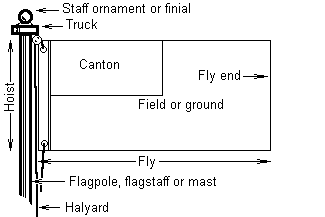
by Zeljko Heimer, 1996-MAY-21, based on image from WBE

Last modified: 2004-09-18 by phil nelson
Keywords: vexillology | terminology | flag terms | protocol |
Links: FOTW homepage |
search |
disclaimer and copyright |
write us |
mirrors
See also:

by Zeljko Heimer, 1996-MAY-21, based on image from WBE
In the United States the US flag is to be displayed on its own right, or on the highest pole. Other flags such as the UN and state flags are to be flown to the United States' flag's left or on lower poles. Do European states have similar rules? If so where does the EU flag fly relative to the flags of the composite states?
Nathan Bliss, 08 November 1996
The only reference I can find (admittedly on a cursory check) to any sort of flag precedence in the UK is from a section in Whitaker's Almanac on days for flying the Union Flag (bizarrely government buildings in the UK only have to fly the national flag on certain days of the year, not all year round), which states that on April 23rd, St George's Day, in England the Cross of St. George may be flown in addition to the Union Flag where there is more than one flagpole available, but not in a superior position. However it does not define what a superior position is! The implication that if only one flagpole is available St. George has to stay in the
flag locker is clear. Certainly on days when the Union Flag is to be flown, here in Winchester the flags of the city and county at the Westgate and Castle are replaced by the Union. If only the county council had two flagpoles on its main offices, I could give a definitive answer.
Roy Stilling, 08 November 1996